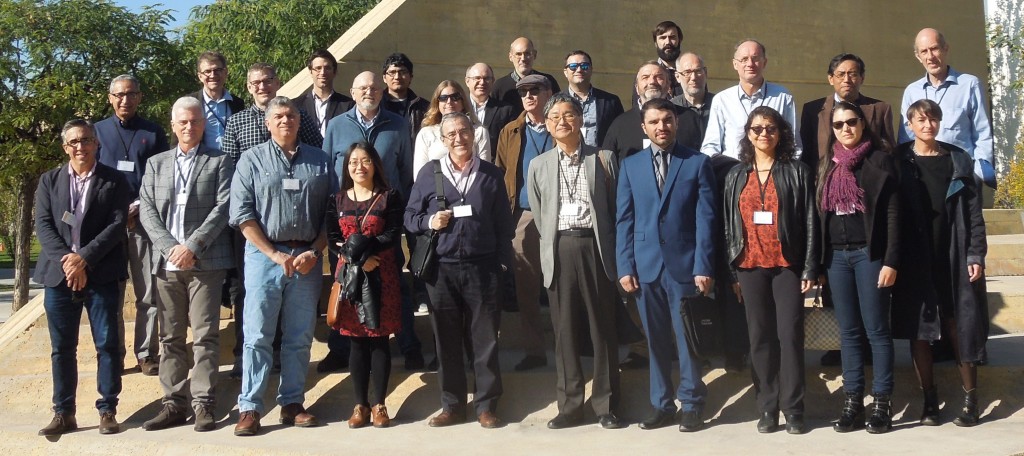The third workshop of M3EF3 was held in Alicante, Spain, on November 16-17, 2017 (workshop website). The workshop was organized by the University of Alicante, Instituto Geologico y Minero de España, Grupo Español de trabajo en Subsidencia del Terreno, Group on Earth Observation (GEO), EU Feder and Spanish Ministery of Economy and Competitiveness and supported by University of Alicante, Cátedra de Movilidad Vectalia, Romanense de Mármoles S.L. About 35 people from 11 countries (China, Colombia, Egypt, Italy, Japan, Mexico, Packistan, Poland, Spain, The Netherlands, USA) attended the meeting.
The workshop was developed in two parts:
- on November 16th, a number of 12 talks have been given discussing the latest results in the field of monitoring, modelling and understanding the ground rupture mechanism (book of abstract);
- on November 17th, a field trip has been carried out in the Guadalentín Valley. This is the area presently characterized by the largest land subsidence due to aquifer overexpolitation in Europe (approx 10 cm/yr with a cumulative sinking of about 2.5 m over the last 3 decades) and the only region in the Europe affected by earth fissure possibly connencted to water pumping developed.
Meeting talks
| 1 – Devin Galloway (USGS, USA) – Earth fissures and surface faults accompanying aquifer-system compaction and land subsidence in the USA Download |
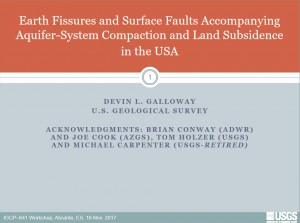 |
| 2 – Dora Carreón-Freyre (UNAM, México) – Mapping and characterisation of ground fracturing in Mexico City |
 |
| 3 – Pietro Teatini (Univ. of Padova, Italy) – A world map of ground ruptures due to groundwater pumping Download |
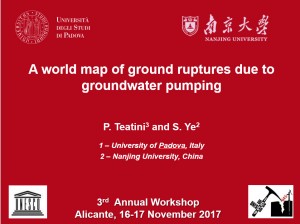 |
| 4 – Adrian Riquelme (Univ. of Alicante, Spain) – Potential use of 3D datasets for the analysis and monitoring of earth fissures Download |
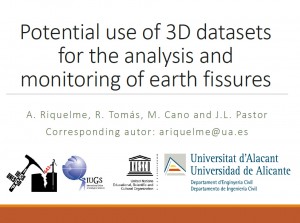 |
| 5 – José Luis Pastor (Univ. of Alicante, Spain) – Geotechnical characterization and mapping of two earth fissures appeared in the Guadalentin Valley after the September 2012, 28th flooding Download |
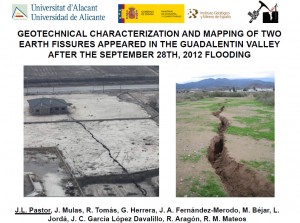 |
| 6 – Gil Ochoa-González (ITESO, México) – Stress / strain analysis caused by groundwater pumping in the faulted basin of Queretaro, Mexico. Insights from a 3D FE groundwater flow and geomechanical modelling approach Download (available after registration to the IGCP641 project) |
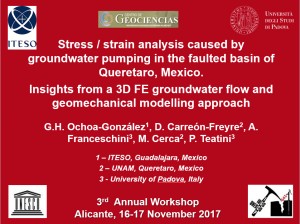 |
| 7 – Shujun Ye (Univ. of Nanjing, China) – Earth fissures caused by extensive aquifer exploitation in China and a novel approach to model earth fissure Download (available after registration to the IGCP641 project) |
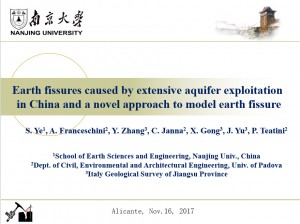 |
| 8 – Matteo Frigo (Univ. of Padova, Italy) – Parametric FE-IE modeling analysis on factors controlling ground ruptures due to groundwater pumping Download (available after registration to the IGCP641 project) |
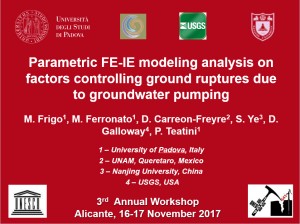 |
| 9 – Najeebullah Kakar (Irrigation Department, Government of Balochistan, Pakistan) – Land subsidence and earth fissures caused by groundwater exploitation in Quetta valley, Pakistan Download |
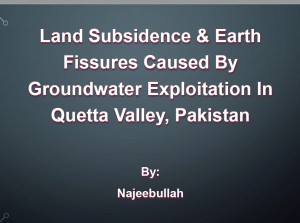 |
| 10 – Mariano Cerca (UNAM, México) – Impact of the 19th September 2017 earthquake on slip of ground fractures related to land subsidence in Mexico City |
 |
| 11 – Enrique Cabral-Cano (UNAM, México) – Triggering of ground subsidence related faults in Mexico City by the Mw8.2 Chiapas and the Mw7.1 Puebla, September 2017 earthquakes Download |
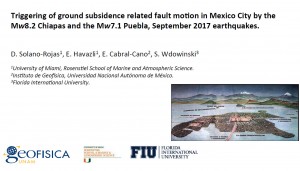 |
| 12 – Raúl Gutiérrez-Calderón (Centro de Evaluación de Riesgo Geológico, Delegación Iztapalapa, México) – Subsidence and fracturing in the municipality of Iztapalapa, Mexico City. Ten years of the Geological Risk Assessment Center |
 |
Movies from the Adrian Riquelme lecture (n.4)
Drone survey (after Arizona Geological Survey – https://www.youtube.com/watch?v=9xdAnftBKvY) |
3D rupture model (after Riquelme et al., Potential use of 3D datasets for the analysis and monitoring of earth fissures) |


